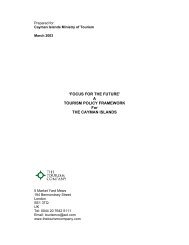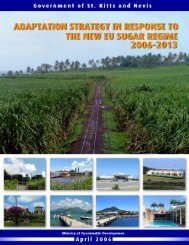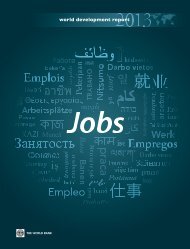Creating
Doing Business in 2006 -- Creating Jobs - Caribbean Elections
Doing Business in 2006 -- Creating Jobs - Caribbean Elections
You also want an ePaper? Increase the reach of your titles
YUMPU automatically turns print PDFs into web optimized ePapers that Google loves.
54 DOING BUSINESS IN 2006<br />
trade barriers. 2 And with faster ships and bigger planes,<br />
the world is shrinking.<br />
Yet Africa’s share of global trade is smaller today<br />
than 25 years ago. So is the Middle East’s, excluding oil<br />
exports. One reason is that entrepreneurs in these regions<br />
face numerous regulatory hurdles to exporting. In<br />
the case of manufactured goods, customs and transport<br />
together represent the single greatest cost of trading<br />
in developing countries—even higher than the cost of<br />
tariffs on their exports imposed by rich countries. Trade<br />
agreements, except those with the European Union and<br />
between Central American countries and the United<br />
States, do not address these high costs. As a consequence,<br />
much of the reform fails to remove the largest<br />
barriers to trade. This is why Doing Business studies<br />
the procedures and time of going through customs<br />
and using trade infrastructure such as roads, ports and<br />
warehousing (box 9.1).<br />
BOX 9.1<br />
What are the Doing Business trade indicators?<br />
Doing Business compiles the procedural requirements for<br />
exporting and importing a standardized cargo of goods.<br />
A procedure is counted from the time the business starts<br />
preparing the necessary documents to the time the cargo<br />
is in the client’s warehouse. Every official procedure is<br />
counted—from the contractual agreement between the<br />
2 parties to the delivery of goods—along with the time<br />
necessary for completion. All documents and signatures<br />
required for clearance of the goods across the border<br />
are also recorded. For example, the importing process is<br />
divided into 4 stages: prearrival documentation necessary<br />
for the cargo to be loaded on the ship or train, procedures<br />
necessary during the vessel’s arrival at the port and the<br />
associated terminal handling, going through customs and<br />
cargo inspections, and inland transport for the cargo’s<br />
delivery to the warehouse (box table 9.1).<br />
On average, the 2 stages that require “hard infrastructure”—ports<br />
and inland transport—account for only a<br />
quarter of the time. The preparation of prearrival documents<br />
accounts for more than half the time (box figure<br />
9.1). The time when the cargo is at sea is not counted.<br />
Once the trader has completed the prearrival documents,<br />
the counting of time stops; it starts again when the ship<br />
is docked. If the destination is a landlocked country, the<br />
time for inland transport includes transit time.<br />
<br />
<br />
<br />
<br />
<br />
<br />
<br />
<br />
<br />
<br />
<br />
<br />
<br />
<br />
Information on the documents and signatures required<br />
and the time to complete each procedure is<br />
provided by local freight forwarders, shipping lines,<br />
customs brokers and port officials, using several assumptions:<br />
The traded product travels in a dry-cargo, 20-foot,<br />
full container load. It is not a hazardous product, does<br />
not require refrigeration and meets international phyto<br />
sanitary and environmental safety standards. The survey<br />
respondents consider several product categories: textile<br />
yarn, fabrics, apparel and clothing accessories, coffee, tea,<br />
cocoa and spices.<br />
BOX TABLE 9.1<br />
Days to complete each stage of importing<br />
Prearrival Port and terminal Customs Inland transport Total<br />
Region documents handling and inspections to warehouse time<br />
OECD high income 8 2 2 2 14<br />
East Asia & Pacifi c 18 3 4 3 28<br />
Latin America & Caribbean 24 4 5 3 36<br />
Middle East & North Africa 25 5 9 4 43<br />
Eastern Europe & Central Asia 25 4 7 7 43<br />
South Asia 24 6 7 10 47<br />
Sub-Saharan Africa 33 8 10 9 59<br />
World 23 5 6 5 39<br />
Source: Doing Business database

















